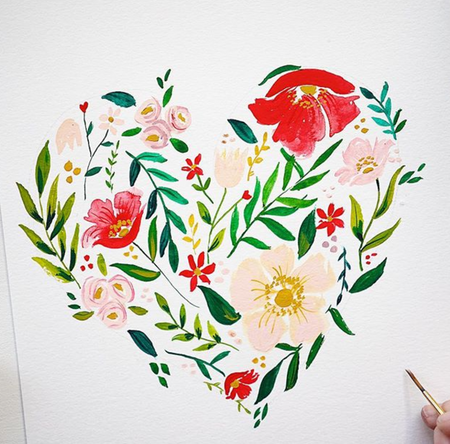How to Paint with Gouache

It's time to learn about gouache!
First thing’s first—let’s learn how to say gouache. It’s like saying “wash” with a g in front of it. Or like saying “gosh” but with a New York accent! Click HERE to hear the pronunciation.

Think of gouache like a thick watercolor. This form of paint consists of opaque pigments that are ground in water and thickened with a glue-like substance. An even better way to describe it would be a midway point between acrylic paint and watercolors. You can achieve the thick opaque look you get with acrylic paint by using it alone, or you can achieve a watercolor effect by adding water. The term gouache derives from a French word guazzo meaning “mud”.
In the following video, Sarah Cray shares some basics about using gouache in your projects!

When it comes to gouache vs acrylic, the benefit to using gouache is it can be reworked even after drying, while acrylic paint cannot. It really comes down to what your project is and what kind of look you want to achieve. If you want something that’s easy to blend and flat with your surface, gouache is the way to go. But if you want something that’s fast drying and has more texture, acrylic is better suited for your needs!
The main difference between watercolor and gouache is the opacity. Watercolor is transparent while gouache dries opaque, filling more of the “tooth” of the paper (the little indents in the paper that change how it feels, such as the texture or smoothness). Gouache also dries quicker (and darker) than watercolor, so there’s not as long of a wait to build layers or paint surrounding areas as there is with watercolor. Another advantage to using gouache over watercolor is that you can paint light colors on top of dark colors, whereas with watercolor you can only make things darker.
All in all, what it really comes down to when deciding which medium to use depends on the look you are wanting! Check out this comparison between a painting made with watercolor and a painting created with gouache:


"Red Poppies" in watercolor
"Valentine Heart" in gouache

Like with any other art medium, it really is as simple as using it however you want! Don’t get bogged down with the specific techniques. Art is all about experimenting and playing, so use it in whatever way best suits your current project. Here are some tips to help you when painting with gouache!
- Use the same brushes you use for watercolor with gouache and not worry about them getting ruined! (Yes, we’re looking at you, acrylics!)
- Add water to your gouache to get a more translucent appearance similar to watercolors.
- Use straight gouache to get a more opaque appearance similar to acrylics.
- Gouache can be used on most any surface. Watercolor paper works great!
- Allow each layer to dry completely in order to add layers on top.

At A Glance



Enjoyed your description of gouache painting. I have used all mediums for painting, even plant dyes. But never gouache. I might be trying it on my next project, nothing can go wrong, I can always start over. Look forward to seeing more from you.
Thank you for Gouache! I’ve been looking for just this. Previously I used mixed medium of watercolor and acrylic on watercolor paper. This will save me a step as well as give me something new to play with.
Thanks for the helpful information about using gouache. Do you have any tips regarding using the gouache in combination with tube watercolor paints rather than strictly by itself. Thanks. I always appreciate your guidance, Sarah.
Will gouache stay colorfast in sunlight or will it fade like watercolors over time? How does one protect it from fading?
Hi!! We want to send fan mail to each of the artists as part of something we call #TheIKEABearProject and were wondering if you have a fan mail address or what address we should send it to? If you prefer not to just put it in the comments, you can email us at 50bearslife@gmail.com ☺️ Thank you in advance!!